Martian orbital grouping
I think everyone was curious about the inside of the Curiosity rover ?
But few people realize or think that the matter is not limited to rovers alone. In fact, everything is much more interesting.
Opportunity and Curiosity rovers are working on the surface of the planet. The stationary spacecraft Phoenix worked in the circumpolar region of Mars from May 25 to November 2, 2008. Communication with the Spirit rover was lost on March 22, 2010. Mars is currently in orbit with 3 actively operating AMCs - Mars Reconnaissance Orbiter, Mars Odyssey, Mars Express . Relatively recently (by space standards), in 2006, Mars Global Surveyor station ceased operation.
And how
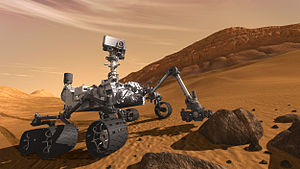 The rover Curiosity has two communication systems. The first has a transmitter and a X-band receiver, with which the rover will communicate directly with the Earth. The second works in the UHF range and is based on the software-defined Electra-Lite radio system developed in JPL specifically for spacecraft. UHF radio is used to communicate with artificial satellites of Mars. Despite the fact that “Curiosity” has the possibility of direct communication, most of the data will pass through the orbiters, since they have more powerful transmitters, larger diameter antennas, and in this mode, a large bandwidth is achieved.
The rover Curiosity has two communication systems. The first has a transmitter and a X-band receiver, with which the rover will communicate directly with the Earth. The second works in the UHF range and is based on the software-defined Electra-Lite radio system developed in JPL specifically for spacecraft. UHF radio is used to communicate with artificial satellites of Mars. Despite the fact that “Curiosity” has the possibility of direct communication, most of the data will pass through the orbiters, since they have more powerful transmitters, larger diameter antennas, and in this mode, a large bandwidth is achieved.
')
When landing, telemetry could be tracked by all three active satellites in Mars orbit. Of these, Mars Odysseus served as a repeater and transmitted telemetry to Earth in streaming mode. On Earth, the signal was received with a delay of 13 minutes and 46 seconds, necessary for the radio signal to overcome the distance between the planets.
Further interesting information follows, little by little, about each satellite, in order of launch.
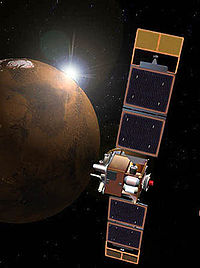 Mars Global Surveyor is an unmanned research station, one of NASA’s most successful Mars exploration projects. The spacecraft was launched on November 7, 1996 from the launch site at Cape Canaveral using the Delta-2 launch vehicle. During the flight, the spacecraft traveled 750 million kilometers in 300 days and on September 11, 1997 reached Mars. Until March 1999, the spacecraft made orbital maneuvers in order to end up in a circular polar orbit at an altitude of 378 kilometers, convenient for mapping the surface of Mars.
Mars Global Surveyor is an unmanned research station, one of NASA’s most successful Mars exploration projects. The spacecraft was launched on November 7, 1996 from the launch site at Cape Canaveral using the Delta-2 launch vehicle. During the flight, the spacecraft traveled 750 million kilometers in 300 days and on September 11, 1997 reached Mars. Until March 1999, the spacecraft made orbital maneuvers in order to end up in a circular polar orbit at an altitude of 378 kilometers, convenient for mapping the surface of Mars.
On January 31, 2001, the unit completed the main mission, but since it was still operational, an extended mission was proposed for it. NASA calculated that Mars Global Surveyor will work at least until December 2006. In addition to mapping the surface of Mars, Mars Global Surveyor serves as a telecommunications satellite for Spirit and Opportunity rovers, retransmitting the data they receive to Earth.
On March 30, 2004, the device photographed the Spirit Spirit rover and traces it left on the Martian surface for 85 days on the planet.
In April 2005, the device photographed the Mars Odyssey and Mars Express vehicles, becoming the first spacecraft to film another vehicle in extraterrestrial orbit.
On November 5, 2006, the connection with the device was lost. Three days before this, the device sent a signal that the position of one of the two solar cells was not adjusted. It is assumed that the incorrect orientation of the batteries could lead to the fact that the signal from the device became too weak to register on Earth. It is planned to attract other vehicles that are currently in orbit and the surface of Mars, to analyze the state of the research station.
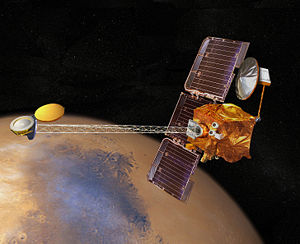 Mars Odyssey - NASA orbiter exploring Mars. The main task facing the apparatus is to study the geological structure of the planet and search for minerals.
Mars Odyssey - NASA orbiter exploring Mars. The main task facing the apparatus is to study the geological structure of the planet and search for minerals.
The device was launched on April 7, 2001 by the Delta-2 launch vehicle. On October 24, the Odyssey arrived in a near-Martian orbit. The device was able to obtain data indicating large reserves of water on Mars. Apparently, in some areas at a depth of about 45 cm, there is a rock that consists of frozen water at 70% by volume. The study of Martian water ice continued the Phoenix apparatus, which sat on the surface of the planet on May 25, 2008. "Odyssey" is used as a repeater for transmitting information from the Spirit and Opportunity Mars rovers. In July 2012, the Odyssey orbit was adjusted to transmit information from the new Curiosity Mars rover.
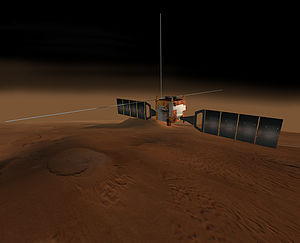 Mars Express is a spacecraft of the European Space Agency, designed to explore Mars.
Mars Express is a spacecraft of the European Space Agency, designed to explore Mars.
On June 2, 2003, Mars-Express launched at the Baikonur cosmodrome using a Soyuz-FG launch vehicle with a Fregat upper stage.
In December 2003, the device arrived at Mars and went into orbit around the planet.
On December 25, 2003, the Beagle-2 lander descended to Mars, but did not make contact.
On September 19, 2005, the life of the device was extended until the end of 2007.
On January 9, 2011, Mars-Express photographed the “reverse”, previously unopened, side of Phobos with a 16-meter resolution and in 3D format; On March 3 of the same year, the unit completed its main mission by flying over this satellite, but continued to function.
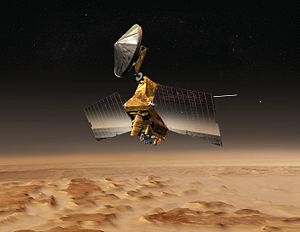 The Martian Proximity Satellite is a multifunctional automatic NASA interplanetary station. Launched on August 12, 2005 from the launch site at Cape Canaveral using the Atlas V launch vehicle. The device reached Mars on March 10, 2006 and began a series of maneuvers to take the required orbit using aerodynamic deceleration (deceleration in the upper atmosphere can significantly save fuel). Orbital maneuvers and various equipment checks and calibrations ended in November 2006, after which the device began work.
The Martian Proximity Satellite is a multifunctional automatic NASA interplanetary station. Launched on August 12, 2005 from the launch site at Cape Canaveral using the Atlas V launch vehicle. The device reached Mars on March 10, 2006 and began a series of maneuvers to take the required orbit using aerodynamic deceleration (deceleration in the upper atmosphere can significantly save fuel). Orbital maneuvers and various equipment checks and calibrations ended in November 2006, after which the device began work.
But few people realize or think that the matter is not limited to rovers alone. In fact, everything is much more interesting.
Opportunity and Curiosity rovers are working on the surface of the planet. The stationary spacecraft Phoenix worked in the circumpolar region of Mars from May 25 to November 2, 2008. Communication with the Spirit rover was lost on March 22, 2010. Mars is currently in orbit with 3 actively operating AMCs - Mars Reconnaissance Orbiter, Mars Odyssey, Mars Express . Relatively recently (by space standards), in 2006, Mars Global Surveyor station ceased operation.
And how do you get the rover connected?
 The rover Curiosity has two communication systems. The first has a transmitter and a X-band receiver, with which the rover will communicate directly with the Earth. The second works in the UHF range and is based on the software-defined Electra-Lite radio system developed in JPL specifically for spacecraft. UHF radio is used to communicate with artificial satellites of Mars. Despite the fact that “Curiosity” has the possibility of direct communication, most of the data will pass through the orbiters, since they have more powerful transmitters, larger diameter antennas, and in this mode, a large bandwidth is achieved.
The rover Curiosity has two communication systems. The first has a transmitter and a X-band receiver, with which the rover will communicate directly with the Earth. The second works in the UHF range and is based on the software-defined Electra-Lite radio system developed in JPL specifically for spacecraft. UHF radio is used to communicate with artificial satellites of Mars. Despite the fact that “Curiosity” has the possibility of direct communication, most of the data will pass through the orbiters, since they have more powerful transmitters, larger diameter antennas, and in this mode, a large bandwidth is achieved.')
When landing, telemetry could be tracked by all three active satellites in Mars orbit. Of these, Mars Odysseus served as a repeater and transmitted telemetry to Earth in streaming mode. On Earth, the signal was received with a delay of 13 minutes and 46 seconds, necessary for the radio signal to overcome the distance between the planets.
Further interesting information follows, little by little, about each satellite, in order of launch.
Mars Global Surveyor, MGS
 Mars Global Surveyor is an unmanned research station, one of NASA’s most successful Mars exploration projects. The spacecraft was launched on November 7, 1996 from the launch site at Cape Canaveral using the Delta-2 launch vehicle. During the flight, the spacecraft traveled 750 million kilometers in 300 days and on September 11, 1997 reached Mars. Until March 1999, the spacecraft made orbital maneuvers in order to end up in a circular polar orbit at an altitude of 378 kilometers, convenient for mapping the surface of Mars.
Mars Global Surveyor is an unmanned research station, one of NASA’s most successful Mars exploration projects. The spacecraft was launched on November 7, 1996 from the launch site at Cape Canaveral using the Delta-2 launch vehicle. During the flight, the spacecraft traveled 750 million kilometers in 300 days and on September 11, 1997 reached Mars. Until March 1999, the spacecraft made orbital maneuvers in order to end up in a circular polar orbit at an altitude of 378 kilometers, convenient for mapping the surface of Mars.On January 31, 2001, the unit completed the main mission, but since it was still operational, an extended mission was proposed for it. NASA calculated that Mars Global Surveyor will work at least until December 2006. In addition to mapping the surface of Mars, Mars Global Surveyor serves as a telecommunications satellite for Spirit and Opportunity rovers, retransmitting the data they receive to Earth.
On March 30, 2004, the device photographed the Spirit Spirit rover and traces it left on the Martian surface for 85 days on the planet.
In April 2005, the device photographed the Mars Odyssey and Mars Express vehicles, becoming the first spacecraft to film another vehicle in extraterrestrial orbit.
On November 5, 2006, the connection with the device was lost. Three days before this, the device sent a signal that the position of one of the two solar cells was not adjusted. It is assumed that the incorrect orientation of the batteries could lead to the fact that the signal from the device became too weak to register on Earth. It is planned to attract other vehicles that are currently in orbit and the surface of Mars, to analyze the state of the research station.
Mars odyssey
 Mars Odyssey - NASA orbiter exploring Mars. The main task facing the apparatus is to study the geological structure of the planet and search for minerals.
Mars Odyssey - NASA orbiter exploring Mars. The main task facing the apparatus is to study the geological structure of the planet and search for minerals.The device was launched on April 7, 2001 by the Delta-2 launch vehicle. On October 24, the Odyssey arrived in a near-Martian orbit. The device was able to obtain data indicating large reserves of water on Mars. Apparently, in some areas at a depth of about 45 cm, there is a rock that consists of frozen water at 70% by volume. The study of Martian water ice continued the Phoenix apparatus, which sat on the surface of the planet on May 25, 2008. "Odyssey" is used as a repeater for transmitting information from the Spirit and Opportunity Mars rovers. In July 2012, the Odyssey orbit was adjusted to transmit information from the new Curiosity Mars rover.
Mars express
 Mars Express is a spacecraft of the European Space Agency, designed to explore Mars.
Mars Express is a spacecraft of the European Space Agency, designed to explore Mars.On June 2, 2003, Mars-Express launched at the Baikonur cosmodrome using a Soyuz-FG launch vehicle with a Fregat upper stage.
In December 2003, the device arrived at Mars and went into orbit around the planet.
On December 25, 2003, the Beagle-2 lander descended to Mars, but did not make contact.
On September 19, 2005, the life of the device was extended until the end of 2007.
On January 9, 2011, Mars-Express photographed the “reverse”, previously unopened, side of Phobos with a 16-meter resolution and in 3D format; On March 3 of the same year, the unit completed its main mission by flying over this satellite, but continued to function.
Mars Reconnaissance Orbiter, MRO
 The Martian Proximity Satellite is a multifunctional automatic NASA interplanetary station. Launched on August 12, 2005 from the launch site at Cape Canaveral using the Atlas V launch vehicle. The device reached Mars on March 10, 2006 and began a series of maneuvers to take the required orbit using aerodynamic deceleration (deceleration in the upper atmosphere can significantly save fuel). Orbital maneuvers and various equipment checks and calibrations ended in November 2006, after which the device began work.
The Martian Proximity Satellite is a multifunctional automatic NASA interplanetary station. Launched on August 12, 2005 from the launch site at Cape Canaveral using the Atlas V launch vehicle. The device reached Mars on March 10, 2006 and began a series of maneuvers to take the required orbit using aerodynamic deceleration (deceleration in the upper atmosphere can significantly save fuel). Orbital maneuvers and various equipment checks and calibrations ended in November 2006, after which the device began work.Source: https://habr.com/ru/post/149331/
All Articles